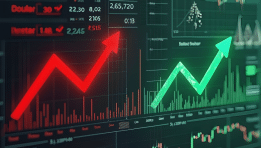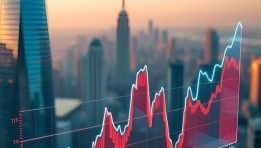Who Really Runs the Global Economy?
The July 2025 ranking of the world’s 50 largest companies by market capitalization provides a unique snapshot of global financial power and innovation. These elite giants collectively shape the course of the global economy, set technological and consumer trends, and employ hundreds of thousands of people worldwide. The list not only allows for direct comparison but also reveals broader megatrends: the overwhelming dominance of the U.S. tech sector, the ascent of Asian powerhouses, the resilience of European brands, and the continued significance of natural resources and energy in the Middle East.
Market Overview: U.S. Tech’s Unprecedented Strength
The top six spots in the global ranking are held by American companies—most of them in technology. Nvidia leads the list with a market capitalization of $4.2 trillion, having overtaken Microsoft ($3.8 trillion), Apple ($3.1 trillion), Alphabet ($2.2 trillion), Amazon ($2.4 trillion), and Meta ($1.1 trillion). Surrounding these giants are titans from the financial sector, consumer goods, pharmaceuticals, and communications: Johnson & Johnson, JPMorgan Chase, Procter & Gamble, Netflix, Visa, Walmart, Berkshire Hathaway, Broadcom, Oracle, Tesla, Pfizer, and others.
The combined market cap of all U.S. companies in the top 50 exceeds $35 trillion—far more than any other continent and nearly triple that of Europe or Asia. This dominance illustrates just how deeply American financial and technological leadership shapes today’s global economic map.
Asia Rising: China, Taiwan, and South Korea Make Their Mark
Despite clear American dominance, Asia is making powerful strides through China, Taiwan, and South Korea. The top 50 list includes Taiwanese chip giant TSMC ($1.2 trillion), South Korea’s Samsung ($316 billion), and three Chinese behemoths—Tencent ($599 billion), Alibaba ($358 billion), and ICBC ($325 billion). Energy and banking giants from other Asian countries also feature.
The total market cap of the Asian companies in the ranking stands at about $4 trillion. While still smaller than the U.S. total, the trend is unmistakably upward, particularly in technology, AI, advanced manufacturing, and consumer electronics. Asian companies are leveraging scale, digital adoption, and domestic demand to close the gap with Western competitors.
Europe: Financial Conservatism and Luxury Brand Power
Europe’s representation in the top 50 focuses on finance, automotive, pharmaceuticals, and luxury goods. Standouts include ASML from the Netherlands ($292 billion), Swiss conglomerate Nestlé ($255 billion), Roche ($259 billion), Denmark’s Novo Nordisk ($290 billion), France’s LVMH ($274 billion), Sanofi ($249 billion), as well as leaders from Germany, the UK, and Switzerland. Despite regulatory headwinds and mature markets, European companies remain global anchors for value, brand strength, and innovation in specific sectors.
The Middle East and Energy: Saudi Arabia’s Rise
Saudi Arabia’s national oil company, Aramco ($1.6 trillion), is the largest non-U.S. company in the ranking. Aramco’s position underscores the ongoing strategic importance of fossil energy, even in an era of digital disruption, and demonstrates how countries with substantial natural resources can create some of the world’s most valuable corporate giants.
Industry Breakdown: Technology, Finance, Energy, and Healthcare
The list of the world’s largest companies highlights four dominant sectors: technology (primarily American and Asian), finance (with major players from the U.S., China, and Europe), energy (Saudi Arabia, the U.S., and China), and healthcare/pharma (Johnson & Johnson, Roche, Novartis, Pfizer, Eli Lilly). Consumer goods companies such as Procter & Gamble and Nestlé, and luxury brands like LVMH, add further depth.
Technology continues to post the fastest growth rates, but finance and energy provide the stable backbone that anchors the global economy during periods of volatility.
Structural Trends: AI, Digitalization, and the Market Cap Gap
The past decade has shown that technology leads the markets—and 2025’s rankings reflect the acceleration of AI, semiconductors, cloud, and cybersecurity. Nvidia is emblematic of this transformation: once a niche graphics company, it now sits at the center of the global AI boom, surpassing even Google, Amazon, and Apple in valuation.
The combined market cap of the top five companies (Nvidia, Microsoft, Apple, Amazon, Alphabet) is higher than the entire German or UK stock market. Meanwhile, the gap between the leaders and the rest of the top 50 is widening, reflecting the power of scale, data networks, and massive R&D investments. These super-giants are increasingly shaping entire sectors, policy debates, and even global geopolitics.
Global Impact: Economy, Employment, and Investment
These 50 mega-corporations wield enormous influence over economies, labor markets, regulation, and technological progress. They create hundreds of thousands of direct jobs, invest tens of billions annually in research and development, and set global standards in information, health, energy, and logistics. For investors, these companies are both anchor holdings and potential sources of risk due to their size, political influence, and exposure to shifting regulatory winds.
Regional Comparisons and Shifting Dynamics
Globally, the U.S. remains the technological and financial superpower. Asia is closing the gap through innovation and market scale. Europe holds its ground through brand strength, global banking, and consumer sectors, while the Middle East builds power through energy wealth. The most visible trends are widening market cap gaps, the relentless rise of digital and AI-driven business models, and an ongoing race for market share in high-value, advanced industries.
The Strategic Outlook: Power, Innovation, and Concentration
The ranking underscores that power in the global economy is concentrating among a handful of tech giants, supported by deep pools of capital and constant innovation. The rise of AI, the integration of digital services, and the expansion into new markets (such as autonomous vehicles, quantum computing, and personalized medicine) will likely further widen the gap between leaders and laggards. However, this concentration also raises questions about regulation, competition, and the resilience of the global economy in the face of shocks or policy shifts.
Comparison, examination, and analysis between investment houses
Leave your details, and an expert from our team will get back to you as soon as possible
* This article, in whole or in part, does not contain any promise of investment returns, nor does it constitute professional advice to make investments in any particular field.
To read more about the full disclaimer, click here- orshu
- •
- 7 Min Read
- •
- ago 4 hours
 THE AMERICAS MARKET CLOSES IN THE RED, DRIVEN BY BROADER SELL-OFF
THE AMERICAS MARKET CLOSES IN THE RED, DRIVEN BY BROADER SELL-OFF
The final trading session of the week for the Americas' markets saw a broad decline, as a wave of selling
- ago 4 hours
- •
- 7 Min Read
The final trading session of the week for the Americas' markets saw a broad decline, as a wave of selling
- orshu
- •
- 6 Min Read
- •
- ago 5 hours
 U.S. Labor Market Weakens Sharply: Job Growth Disappoints, Prior Data Revised Down Heavily
U.S. Labor Market Weakens Sharply: Job Growth Disappoints, Prior Data Revised Down Heavily
The latest U.S. jobs report paints a troubling picture of the labor market's momentum. The economy added just 73,000 jobs in
- ago 5 hours
- •
- 6 Min Read
The latest U.S. jobs report paints a troubling picture of the labor market's momentum. The economy added just 73,000 jobs in
- orshu
- •
- 7 Min Read
- •
- ago 6 hours
 USA Rare Earth (USAR): A Strategic Bet on America’s Critical Mineral Independence
USA Rare Earth (USAR): A Strategic Bet on America’s Critical Mineral Independence
Initiation with a $16 Price Target — What's the Rationale? Cantor Fitzgerald has initiated coverage on USA Rare Earth (Ticker: USAR) with
- ago 6 hours
- •
- 7 Min Read
Initiation with a $16 Price Target — What's the Rationale? Cantor Fitzgerald has initiated coverage on USA Rare Earth (Ticker: USAR) with
- orshu
- •
- 6 Min Read
- •
- ago 7 hours
 ExxonMobil Q2 2025 Earnings: Operational Strength Amid Net Income Decline
ExxonMobil Q2 2025 Earnings: Operational Strength Amid Net Income Decline
ExxonMobil (NYSE: XOM) released its Q2 2025 earnings report, highlighting robust operational metrics and continued cost efficiencies, despite a notable
- ago 7 hours
- •
- 6 Min Read
ExxonMobil (NYSE: XOM) released its Q2 2025 earnings report, highlighting robust operational metrics and continued cost efficiencies, despite a notable












